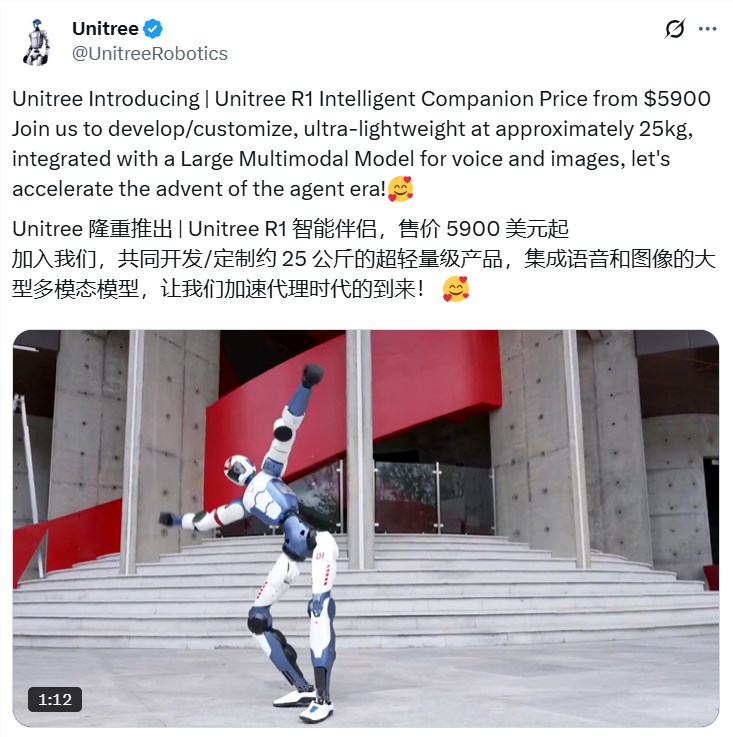Competition in the humanoid robot industry has become increasingly fierce in recent years, and Chinese robot manufacturer Unitree Robotics has once again sparked industry discussions with its innovative technology and highly competitive pricing strategy. On July 25, 2025, Unitree officially launched its new humanoid robot R1 Smart Companion, with a starting price of only 39,900 RMB (approximately 5,900 USD), becoming the world's first full-size humanoid robot priced below 6,000 USD. This breakthrough pricing not only sets a new low for the market price of humanoid robots but also brings new possibilities for individual developers, research institutions, and potential consumer markets.

R1 Robot: Ultra-light Design and Powerful Mobility
According to official information released by Unitree, the R1 robot weighs approximately 25 kilograms and is about 121 centimeters tall, equipped with 26 joints, demonstrating impressive mobility. Official promotional videos show that the R1 can perform backflips, handstands, boxing moves, and downhill running, with flexibility comparable to professional athletes. These functions are usually found in high-end robots that cost several times more, while the R1 achieves this performance at a price of less than 6,000 USD.
The R1 is equipped with a multi-modal large language model, integrating speech recognition and image recognition features, as well as a binocular vision system, four microphone arrays, and a high-performance 8-core CPU and GPU. This allows the R1 not only to execute pre-set actions but also to have certain intelligent interaction potential. Unitree stated that the target users of the R1 are mainly individual developers and early research teams, positioning it as a modular training platform, with future potential for expansion into lightweight industrial applications.
Price Revolution: Competitive with High-end, Cost is Just a Fraction
Compared to Unitree's previous product line, the R1's price is highly disruptive. The starting price of Unitree's G1 humanoid robot is 99,000 RMB (about 16,000 USD), while the flagship model H1 costs as much as 650,000 RMB (about 90,800 USD). The R1's pricing is only one-third of the G1's, far lower than other competitors in the market. For example, Tesla's Optimus robot is expected to cost around 20,000 USD after mass production, while Figure AI's Figure02 and Apptronik's Apollo robots are priced around 50,000 USD. The release of the R1 undoubtedly sets a new price benchmark for the industry.
Analysts point out that the low price of the R1 is due to Unitree's optimization of manufacturing costs and the maturity of China's robot industry supply chain. By adopting lightweight design and modular production, Unitree significantly reduced production costs while retaining core functions, offering a high-value option for the market.
Industry Impact: Accelerating the Popularization of Humanoid Robots
The release of Unitree R1 coincides with the company's key phase of preparing for an initial public offering (IPO) on the mainland stock exchange. According to reports, Unitree has recently submitted IPO tutoring documents to the China Securities Regulatory Commission, aiming to become the first pure humanoid robot manufacturer to list on the mainland. This low-price strategy is considered an important move for Unitree to further expand its market influence before the listing.
Industry experts believe that the extremely low pricing of the R1 will have a profound impact on the global humanoid robot market. Compared to Western competitors, Unitree's cost advantage may force other manufacturers to accelerate price reductions or optimize product designs. At the same time, the R1's lightweight and modular characteristics make it suitable for widespread application in education, research, and entertainment. However, Unitree also reminds on its official website that the humanoid robot industry is still in the early exploration stage, and individual users should fully understand its technical limitations. The R1 is currently not suitable for direct daily use as a home robot.
Future Outlook: Bridging the Gap from Lab to Real Life
Although the R1 demonstrates impressive mobility and intelligent potential, its practical application still needs time to verify. Currently, the R1's level of intelligence and autonomy has not been fully disclosed, and most of the demonstrated actions may rely on remote control or pre-programmed scripts. To become a true home or industrial assistant, the R1 needs further breakthroughs in sensor integration, environmental perception, and AI algorithms.
Unitree stated that the modular design of the R1 allows users to customize and develop according to their needs, providing a broad space for innovation in the developer community. In the future, as software updates and hardware module upgrades continue, the R1 is expected to play a role in more scenarios, such as light industrial tasks, education and training, and even entertainment performances.
The release of Unitree R1 marks the beginning of a new pricing era in the humanoid robot market. Its ultra-low pricing and powerful mobility not only challenge the current industry status quo but also open the door for ordinary consumers and developers to access cutting-edge robot technology. However, the actual performance and application prospects of the R1 still need market verification.










